Investigation of Lean Production Knowledge among Employees in Building Inspection Organizations
Abstract
1. Introduction
- Time-schedule control;
- Material usage (waste) control;
- Budget control;
- Control of administrative processes;
- Optimization of human resources in production [11].
- This study is the first of its kind in the research literature that examines the lean production approach in construction inspection organizations;
- This research, which determines scientific awareness about this issue in the construction sector, is an original study;
- In light of the data collected as a result of the research, it has been determined that employees in the relevant sector are not conscious about this issue. These findings may serve as the starting point for future research;
- The fact that this study is the first in the construction industry to use data mining techniques to determine people’s levels of awareness is another novel contribution to the field;
- Within the scope of the research findings, it has been clearly seen that there is a need to increase social-scale education activities on this issue in Turkey.
2. Materials and Methods
2.1. Questionnaire Design and Implementation
2.2. Analysis Methods
2.3. SPSS Reliability Analysis
2.4. Association Rules
3. Results
3.1. SPSS Reliability Analysis and Survey Main Results
3.2. WEKA Analysis Results
- The construction process based on applications that aim at a lower cost, a higher efficiency, and less waste is defined as “lean construction”. “Do you have any information about the defined system?” (Question 8 of the survey);
- “Do you think that the lack of information about the Law on Construction Supervision No. 4708 and the relevant legislation can cause waste?” (Question 21 of the survey);
- “Do you think that raising awareness on lean construction and waste issues and increasing its practices will make positive contributions to the sector?” (Question 28 of the survey).
3.2.1. The First Situation: “Do You Know about the Concept of Lean Construction?” Determined as the Class Label
3.2.2. The Second Situation: “Do You Think That the Lack of Information about the Law on Construction Supervision No. 4708 and the Related Legislation May Cause Waste?” Determined as the Class Label
3.2.3. The Third Situation: “Do You Think That Raising Awareness on Lean Construction and Waste Issues and Increasing Its Practices Will Make Positive Contributions to the Sector?” Determined as the Class Label
4. Discussion
- In the construction industry, lean manufacturing is a relatively new topic;
- Although there are many researchers in different sectors working in this field [5,6,26], etc., the construction sector is still untouched. There are studies on lean production in the construction sector [9,10,11,12,13,14,15,31] (albeit fewer than in industries such as industry, medicine, and economy). However, there has been no study (except for a study by authors) on lean production in inspection institutions in the construction sector [11] which is a sub-branch of the sector and important for the inspection mechanism. In this study, answers were sought to determine whether there was awareness of this subject and the extent of the awareness of scientific facts. This study is unique in this respect. Issues such as waste, losses, and inefficient work are important in the construction industry, where production is based on limited resources. One of the aims of this study was to draw attention to these issues;
- This study primarily aimed to measure the level of awareness of lean production. Analyzing the current situation is important for understanding the benefits of this concept;
- It is clear that there is insufficient awareness of lean production among the employees of building inspection companies in Turkey. However, as can be seen in Figure 9, employees believed that some of the waste was due to bureaucratic obstacles (in the opinion of 275/343 participants). These and similar cases show that authorized institutions have important duties in this regard;
- In one of the studies in the literature [10], it was stated that there was a lack of information on this subject. This result indicates a lack of education, which was among the findings of this study;
- The proposal by a study in [12] to develop a community mindset, which is among the challenges in implementing DfMA in Australia, is in line with the results of this study. The importance of community development on the subject was emphasized in the implementation of lean construction. Similarly, in another study [7], the importance of reducing losses by applying lean production was explained and it was stated that the level of knowledge on this subject should be increased. The results of all these studies on lean production in the construction sector are compatible with the results of this study, which is the first study to measure the knowledge of lean production among building inspection employees;
- Both the contribution of lean production in Industry 4.0 [13] and the use of PDCA cycle with lean production [14] studies emphasized the application of lean production in companies for process improvement and sustainability. Considering the importance of raising awareness and education in the application of lean production, the results of these studies are also in line with the results of the study;
- The limitations of this study are as follows: it was carried out only in Adana, there was difficulty in establishing a systematic method due to the high turnover rate of the employees of the building inspection companies, the building inspection companies have to inspect different construction companies, and no comparison could be made because there is no other similar study in the literature. It is recommended to pay attention to these points in future studies.
5. Conclusions
- The building inspection staff should be educated on these topics. The training should clearly state the concept of lean manufacturing, its content, and how it will be implemented;
- Efforts should be made to reduce all waste by making applications on the basis of units;
- Those responsible for lean production processes should be identified, and controls should be created at all stages of implementation. Corrective-preventive actions should be carried out in parts that do not comply with the planning;
- All these processes should be recorded and reported, and improvements should be standardized. In addition, in-house training periods should be determined;
- In summary, it is necessary to ensure full participation of all stakeholders in order to make the application of lean production principles an organizational culture in building inspection organizations.
Author Contributions
Funding
Institutional Review Board Statement
Informed Consent Statement
Data Availability Statement
Conflicts of Interest
References
- Bayram, S.; Aydınlı, S.; Budak, A.; Oral, E. Ethical problems in the production and inspection of construction in Turkey. Pamukkale Univ. J. Eng. Sci. 2018, 24, 461–467. [Google Scholar] [CrossRef]
- Womack, J.; Jones, D. The Evolution of Lean Thinking and Practice, 1st ed.; Netland, T.H., Powell, D.J., Eds.; The Routledge Companion to Lean Management: New York, NY, USA, 2016; p. 6. [Google Scholar]
- Apilioğulları, L. Yalın Dönüşüm Verimliliğin Şifresi, 1st ed.; Aura Books: Istanbul, Turkey, 2010. [Google Scholar]
- Kara, Y. New Models for U-Type Assembly Line Balancing Problems and an Application in Automotive Supply Industry. Ph.D. Thesis, Selcuk University Institute of Social Sciences, Konya, Turkey, 2004. [Google Scholar]
- Can, G.; Taş, E.F. Analysis of non-physical waste causes affecting the construction process. J. Fac. Eng. Archit. Gazi Univ. 2021, 36, 655–668. [Google Scholar] [CrossRef]
- Pinto, C.M.A.; Mendonça, J.; Babo, L.; Silva, F.J.G.; Fernandes, J.L.R. Analyzing the Implementation of Lean Methodologies and Practices in the Portuguese Industry: A Survey. Sustainability 2022, 14, 1929. [Google Scholar] [CrossRef]
- Awad, T.; Guardiola, J.; Fraíz, D. Sustainable Construction: Improving Productivity through Lean Construction. Sustainability 2021, 13, 13877. [Google Scholar] [CrossRef]
- Gleeson, F.; Townend, J. Lean Construction in the Corporate World of the UK Construction Industry; University of Manchester, School of Mechanical, Aerospace, Civil and Construction Engineering: Manchester, UK, 2007. [Google Scholar]
- Harsha, N.; Suresh, A.V.; Nagaraj, N. Implementation of Lean Concepts in the Construction Engineering Project. Int. J. Eng. Res. Technol. 2013, 2, 1078–1095. [Google Scholar]
- Aureliano, F.; Costa, A.A.F.; Junior, I.F.; Rodrigues, R.A. Application of lean manufacturing in construction management. Procedia Manuf. 2019, 38, 241–247. [Google Scholar] [CrossRef]
- Keleş, A.E.; Yılmaz, H.K. A Study for the Awareness of Lean Construction in Building Inspection Firms, 1st ed.; Lambert Academic Publishing: Chisinau, Moldova, 2021. [Google Scholar]
- Langston, C.; Zhang, W. DfMA: Towards an Integrated Strategy for a More Productive and Sustainable Construction Industry in Australia. Sustainability 2021, 13, 9219. [Google Scholar] [CrossRef]
- Singh, K.; Jha, S. Lean Manufacturing—An analytical approach towards Industry 4.0. In Proceedings of the 2nd International Conference on Smart Electronics and Communication (ICOSEC), Trichy, India, 7–9 October 2021; pp. 1690–1695. [Google Scholar] [CrossRef]
- Milosevic, M.; Djapan, M.; D’Amato, R.; Ungureanu, N.; Ruggiero, A. Sustainability of the Production Process by Applying Lean Manufacturing Through the PDCA Cycle—A Case Study in the Machinery Industry. Advances in Manufacturing Engineering and Materials II. ICMEM 2021. Lecture Notes in Mechanical Engineering; Springer: Cham, Switzerland, 2021. [Google Scholar] [CrossRef]
- Feldmann, F.G. Towards Lean Automation in Construction—Exploring Barriers to Implementing Automation in Prefabrication. Sustainability 2022, 14, 12944. [Google Scholar] [CrossRef]
- Üzgeç, M. A Study to Determine the Occupational Safety Awareness of Employees in a Corporate Company. Master’s Thesis, Çukurova University Graduate School of Natural and Applied Sciences, Adana, Turkey, 2018; p. 107. [Google Scholar]
- Keleş, A.E.; Önen, E.; Górecki, J. Determination of Green Building Awareness: A Study in Turkey. Sustainability 2022, 14, 11943. [Google Scholar] [CrossRef]
- Irmak, S.K.; Köksal, C.D.; Asilkan, Ö. Estimating the future patient densities of hospitals with data mining methods. Int. J. Alanya Bus. Fac. 2012, 4, 101–114. [Google Scholar]
- Bhatla, N.; Jyoti, K. An analysis of heart disease prediction using different data mining techniques. Int. J. Eng. Res. Technol. 2012, 1, 1–4. Available online: https://www.ijert.org/research/an-analysis-of-heart-disease-prediction-using-different-data-mining-techniques-IJERTV1IS8282.pdf (accessed on 2 March 2021).
- Savaş, S.; Topaloğlu, N.; Yılmaz, M. Data mining and application examples in Turkey. Istanb. Commer. Univ. J. Sci. 2012, 11, 1–23. [Google Scholar]
- Garner, S.R. Weka: The Waikato Environment for Knowledge Analysis. Proc New Zealand Computer Science Research Students Conference. 1995, pp. 57–64. Available online: https://www.cs.waikato.ac.nz/~ml/publications/1995/Garner95-WEKA.pdf (accessed on 17 February 2021).
- Zupan, B.; Demsar, J. Open-source tools for data mining. Clin. Lab. Med. 2008, 28, 37–54. Available online: http://eprints.fri.uni-lj.si/893/1/2008-OpenSourceDataMining.pdf (accessed on 26 February 2021). [CrossRef][Green Version]
- Keleş, M.K. Breast cancer prediction and detection using data mining classification algorithms: A comparative study. Teh. Vjesn. 2019, 26, 149–155. [Google Scholar] [CrossRef]
- Keleş, A.E.; Kaya Keleş, M. Adana İnşaat Sektörü Çalışanlarının Verimlilikleri Üzerine Bir Araştırma. El-Jazari J. Sci. Eng. 2018, 5, 605–609. [Google Scholar] [CrossRef]
- Bajjou, M.S.; Chafi, A. Barriers of lean construction implementation in the Moroccan construction industry. AIP Conf. Proc. 2018, 1952, 1. [Google Scholar] [CrossRef]
- Yağız, S. Türkiye’de yapı Denetim Uygulaması ve Konut Niteliğine Etkisi: Bursa Alan Çalışması. Master’s Thesis, Bursa Uludağ University Institute of Science and Technology, Bursa, Turkey, 2019. [Google Scholar]
- Özdamar, K. Statistical Data Analysis with Package Programs, 4th ed.; Kaan Publishing: Eskisehir, Turkey, 2004; pp. 279–340. [Google Scholar]
- Agrawal, R.; Srikant, R. Fast algorithms for mining association rules in large databases. In Proceedings of the 20th International Conference on Very Large Data Bases, San Francisco, CA, USA, 12–15 September 1994; pp. 487–499. [Google Scholar]
- Kaya, M.; Keleş, A.E.; Oral, E.L. Construction crew productivity prediction by using data mining methods. Procedia-Soc. Behav. Sci. 2014, 141, 1249–1253. [Google Scholar] [CrossRef][Green Version]
- Memon, A.; Akhund, M.; Laghari, A.; Imad, H.; Bhangwar, S. Adoptability of lean construction techniques in Pakistan’s construction industry. Civ. Eng. J. 2018, 4, 2328–2337. [Google Scholar] [CrossRef]
- Eriksson, P.E. Improving construction supply chain collaboration and performance: A lean construction pilot project. Supply Chain. Manag. 2010, 15, 394–403. [Google Scholar] [CrossRef]
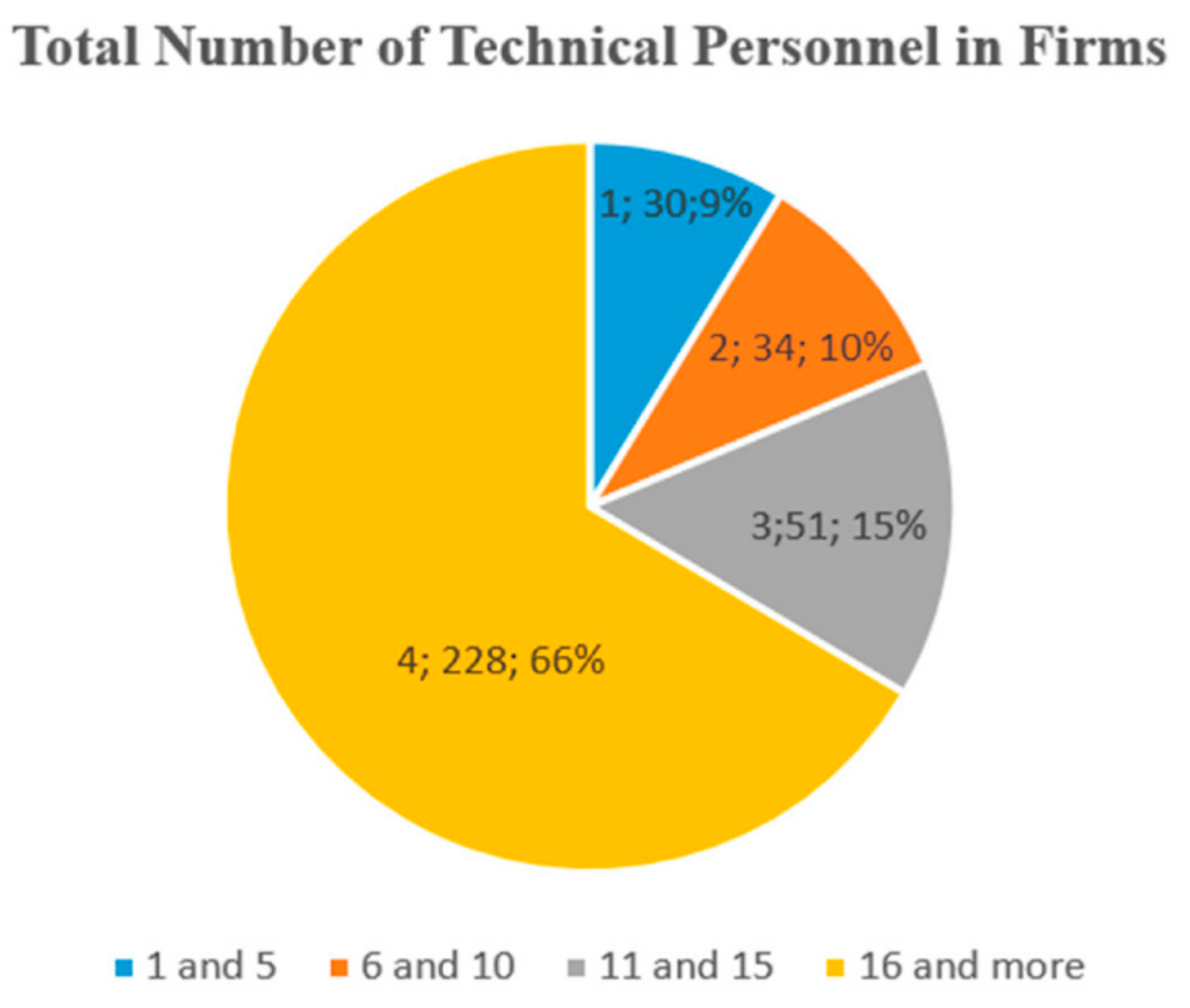

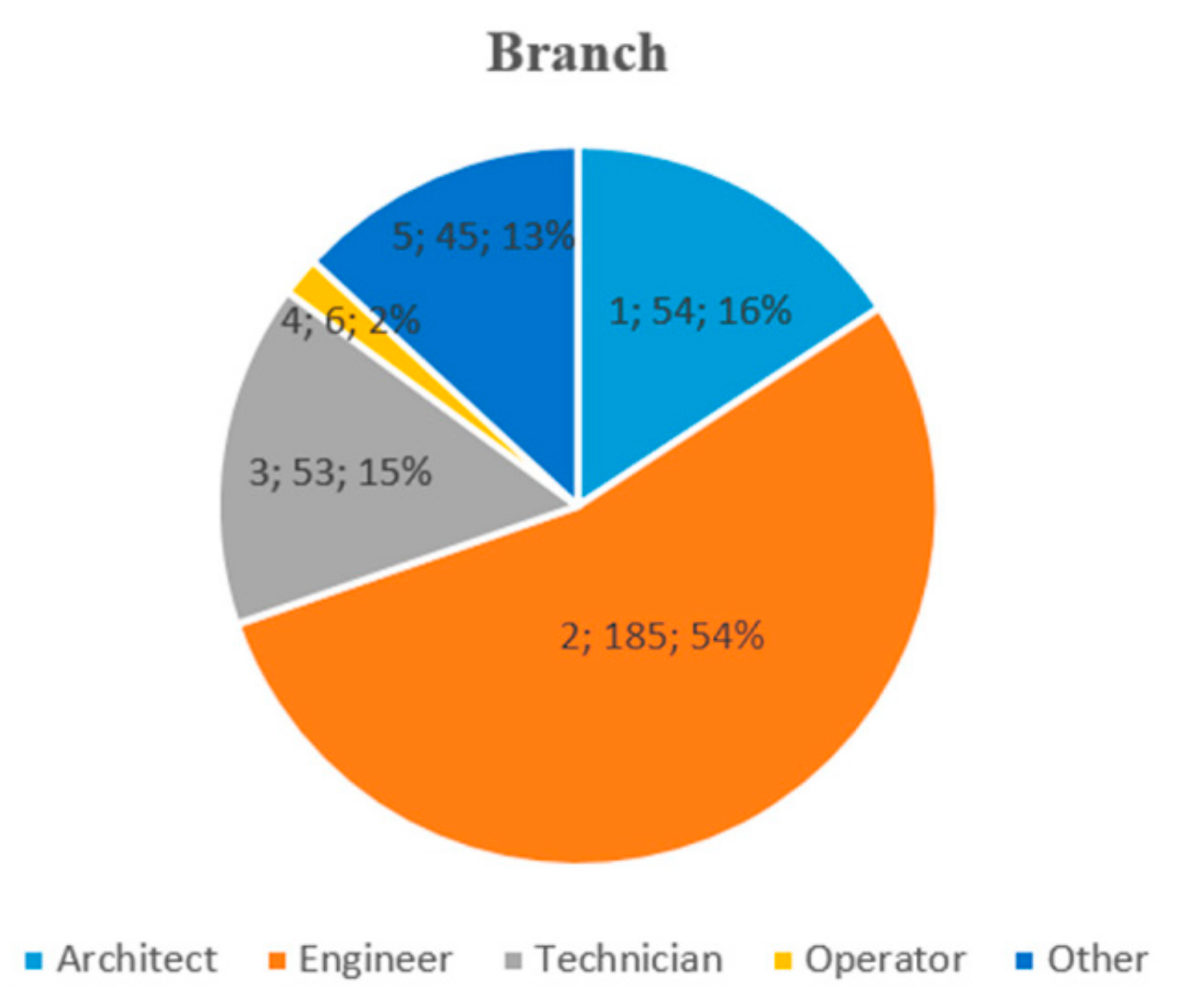



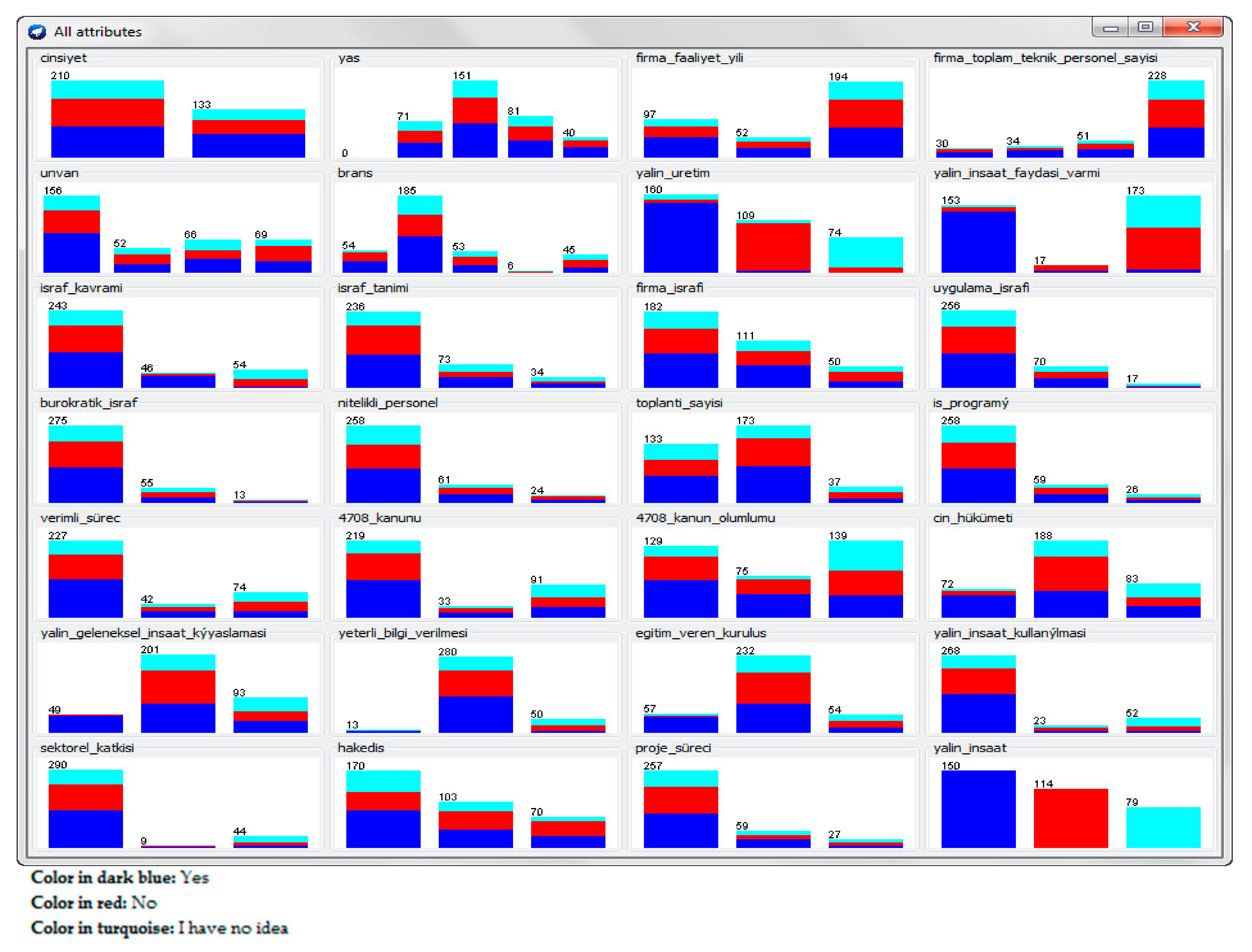
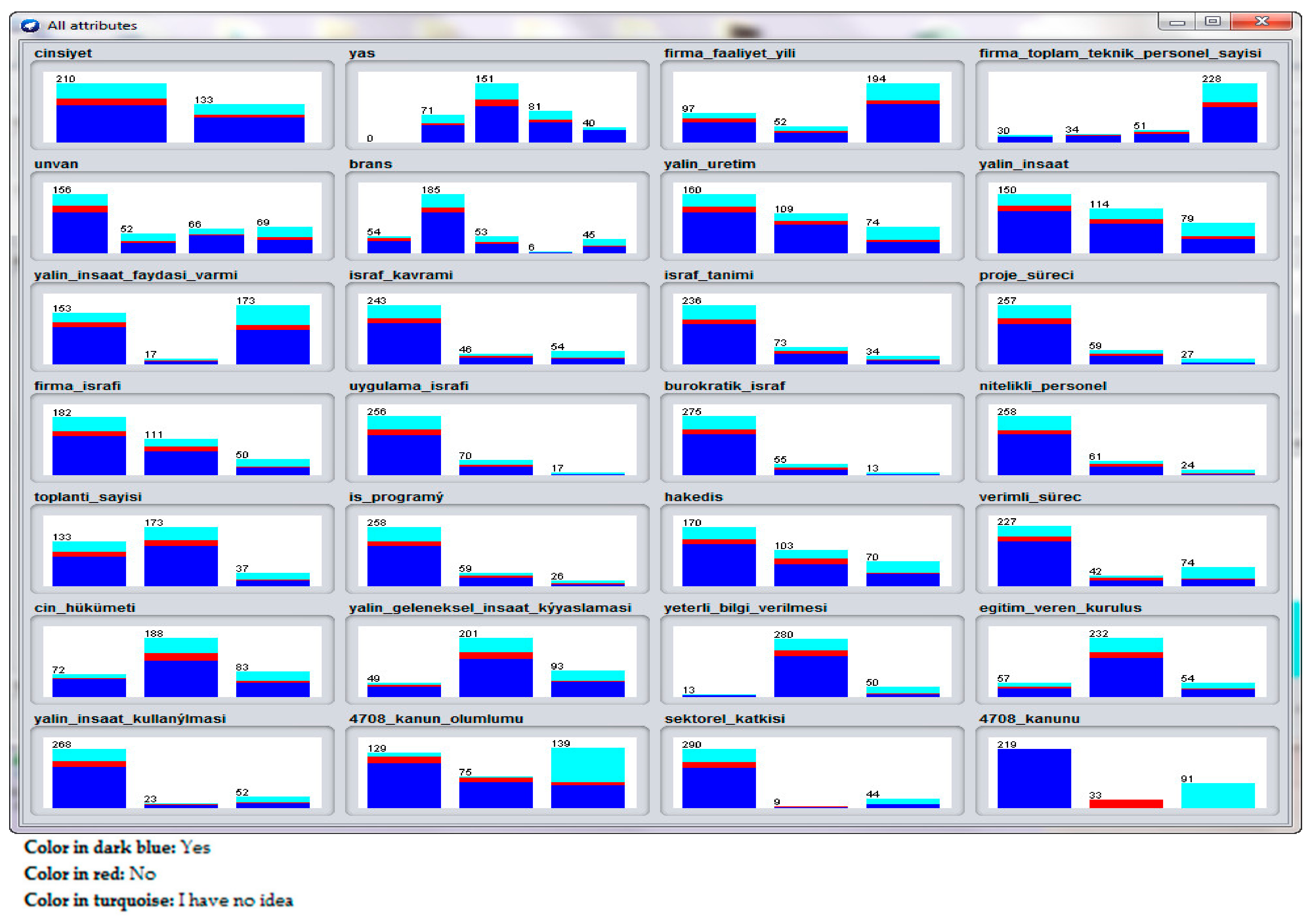
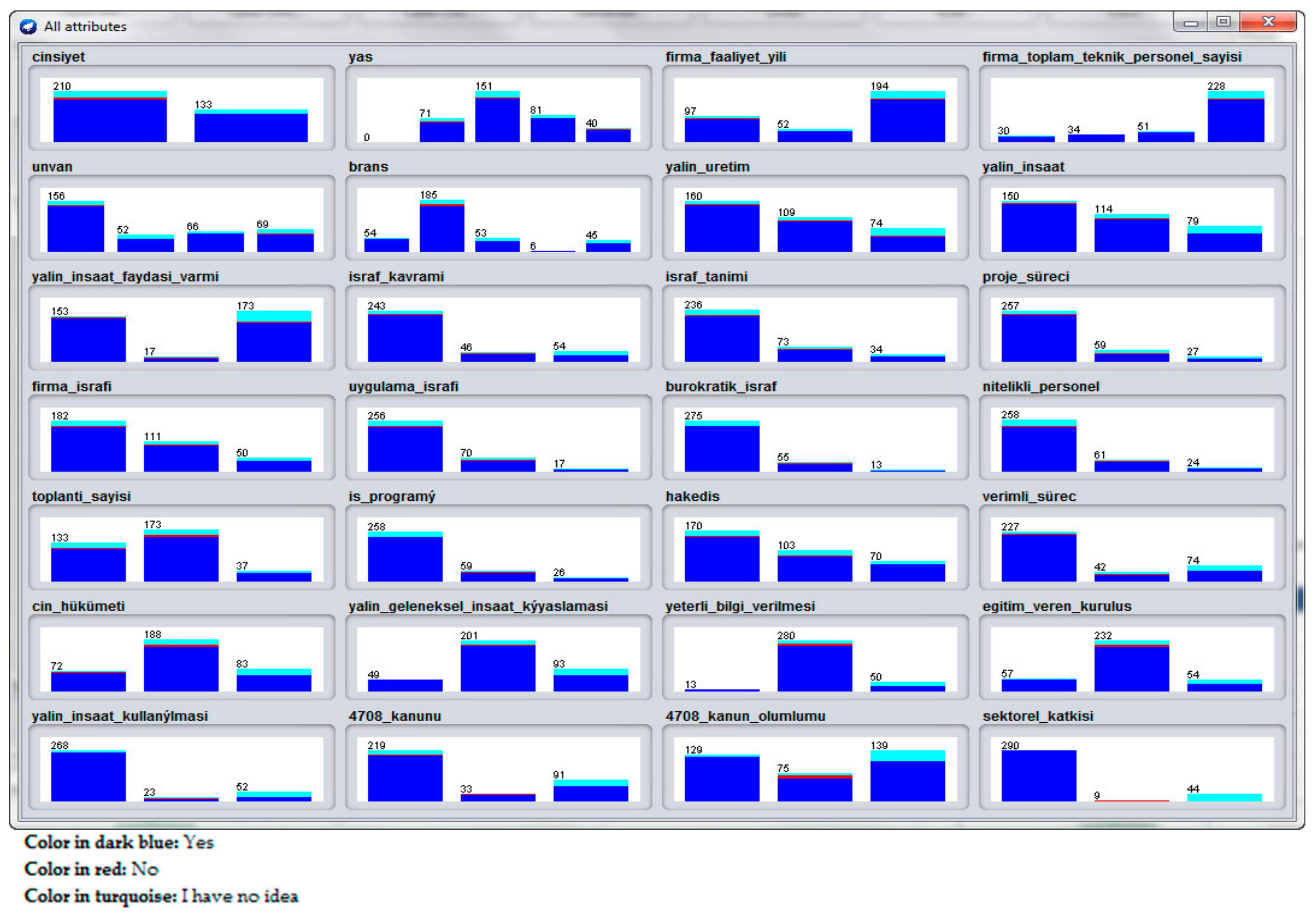
| N | % | |||
| Cases | Used | 343 | 100.0 | |
| Excluded * | 0 | 0.0 | ||
| Total | 343 | 100.0 | ||
| Reliability Statistics | ||||
| Cronbach’s Alpha | Number of Items | |||
| 0.815 | 22 | |||
| Rules No. | Association Rules | Reliability Value | ||
|---|---|---|---|---|
| Properties of the Rules | ⇒ | Class Label Attribute | ||
| 1 | Lean Manufacturing = 1, Lean Construction Beneficial = 1, Bureaucratic Waste = 1 | ⇒ | Lean Construction = 1 | conf:(1) |
| 2 | Lean Manufacturing = 1, Lean Construction Beneficial = 1, Bureaucratic Waste = 1, Sectoral Contribution = 1 | ⇒ | Lean Construction = 1 | conf:(1) |
| 3 | Lean Manufacturing = 1, Lean Construction Beneficial = 1, Project Process = 1 | ⇒ | Lean Construction = 1 | conf:(0.98) |
| 4 | Lean Manufacturing = 1, Lean Construction Beneficial = 1, Project Process = 1, Sectoral Contribution = 1 | ⇒ | Lean Construction = 1 | conf:(0.98) |
| 5 | Lean Manufacturing = 1, Lean Construction Beneficial = 1, Bureaucratic Waste = 1, Using Lean Construction = 1 | ⇒ | Lean Construction = 1 | conf:(0.98) |
| 6 | Lean Manufacturing = 1, Lean Construction Beneficial = 1, Efficient Process = 1 | ⇒ | Lean Construction = 1 | conf:(0.98) |
| 7 | Lean Manufacturing = 1, Lean Construction Beneficial = 1, Efficient Process = 1, Sectoral Contribution = 1 | ⇒ | Lean Construction = 1 | conf:(0.98) |
| 8 | Lean manufacturing = 1, Lean Construction Beneficial = 1, Bureaucratic Waste = 1, 4708 Law = 1 | ⇒ | Lean Construction = 1 | conf:(0.98) |
| 9 | Lean Manufacturing = 1, Lean Construction Beneficial = 1, Bureaucratic Waste = 1, Qualified Personnel = 1 | ⇒ | Lean Construction = 1 | conf:(0.97) |
| 10 | Lean Manufacturing = 1, Lean Construction Beneficial = 1, Project Process = 1, App Waste = 1 | ⇒ | Lean Construction = 1 | conf:(0.97) |
| Features of Association Rules | Definitions of Features |
|---|---|
| Lean Manufacturing = 1 | The concept of lean production is known. |
| Lean Construction Beneficial = 1 | The concept of lean construction is found to be useful. |
| Bureaucratic Waste = 1 | Excessive bureaucratic work is thought to be wasteful. |
| Sectoral Contribution = 1 | It is believed that an increase in lean construction practices will make positive contributions to the sector. |
| Project Process = 1 | It is thought that wastes occur in all processes of work from the project preparation stage to the delivery. |
| Using Lean Construction = 1 | Using the concept of lean structure in practice is considered. |
| Efficient Process = 1 | The process considered efficient in the construction process is thought to account for only 43% of the entire process. |
| 4708 Law = 1 | It is thought that there is a lack of information about the Building Inspection Law No. 4708. |
| Qualified Employee = 1 | Wastage is thought to be due to unskilled employees. |
| App Waste = 1 | Delays due to application errors are defined as waste. |
| Rules No. | Association Rules | Reliability Value | ||
|---|---|---|---|---|
| Properties of the Rules | ⇒ | Class Label Attribute | ||
| 1 | Qualified Employee = 1, 4708 Law Positive Effect = 1, Sectoral Contribution = 1 | ⇒ | 4708 Law = 1 | conf:(0.89) |
| 2 | Qualified Employee = 1, 4708 Law Positive Effect = 1 | ⇒ | 4708 Law = 1 | conf:(0.88) |
| 3 | Bureaucratic Waste = 1, 4708 Law Positive Effect = 1, Providing Adequate Information = 2 | ⇒ | 4708 Law = 1 | conf:(0.87) |
| 4 | Waste Definition = 1, Implementation Waste = 1, Bureaucratic Waste = 1, Efficient Process = 1, Providing Adequate Information = 2, Sectoral Contribution = 1 | ⇒ | 4708 Law = 1 | conf:(0.86) |
| 5 | Waste Definition = 1, Implementation Waste = 1, Efficient Process = 1, Providing Adequate Information = 2, Sectoral Contribution = 1 | ⇒ | 4708 Law = 1 | conf:(0.86) |
| 6 | 4708 Law Positive Effect = 1, Providing Adequate Information = 2, Sectoral Contribution = 1 | ⇒ | 4708 Law = 1 | conf:(0.86) |
| 7 | Waste Definition = 1, Qualified Employee = 1, Efficient Process = 1, Providing Adequate Information = 2, Sectoral Contribution = 1 | ⇒ | 4708 Law = 1 | conf:(0.86) |
| 8 | 4708 Law Positive Effect = 1, Providing Adequate Information = 2 | ⇒ | 4708 Law = 1 | conf:(0.85) |
| 9 | Waste Definition = 1, Qualified Employee = 1, Efficient Process = 1, Providing Adequate Information = 2, Using Lean Construction = 1 | ⇒ | 4708 Law = 1 | conf:(0.85) |
| 10 | 4708 Law Positive Effect = 1, Providing Adequate Information = 2, Using Lean Construction = 1 | ⇒ | 4708 Law = 1 | conf:(0.85) |
| Features of Association Rules | Definitions of Features |
|---|---|
| Qualified Employee = 1 | It is thought that there is wastage due to unskilled employees. |
| 4708 Law Positive Effect = 1 | Building Control Law No. 4708 is thought to contribute positively to the construction process. |
| Sectoral Contribution = 1 | It is believed that an increase in lean construction practices will make positive contributions to the sector. |
| Bureaucratic Waste = 1 | Excessive bureaucratic work is thought to be wasteful. |
| Providing Adequate Information = 2 | It is thought that sufficient information is not given about lean structure concepts. |
| Waste Definition = 1 | The definition “waste is anything that does not contribute to the production process” is correct. |
| Implementation Waste = 1 | Delays and disruptions caused by application errors are considered a waste. |
| Efficient Process = 1 | The process considered efficient in the construction process is thought to account for only 43% of the entire process. |
| Using Lean Construction = 1 | It is thought that the concept of lean construction should be used in practice. |
| Rules No. | Association Rules | Reliability Value | ||
|---|---|---|---|---|
| Properties of the Rules | ⇒ | Class Label Attribute | ||
| 1 | Project process = 1, Work Program = 1, Providing Adequate Information = 2, Using Lean Construction = 1 | ⇒ | Sectoral Contribution = 1 | conf:(0.99) |
| 2 | Work Program = 1, Providing Adequate information = 2, Using Lean Construction = 1 | ⇒ | Sectoral Contribution = 1 | conf:(0.99) |
| 3 | Waste Concept = 1, Providing Adequate Information = 2, Using Lean Construction = 1 | ⇒ | Sectoral Contribution = 1 | conf:(0.99) |
| 4 | Efficient Process = 1, Providing Adequate Information = 2, Using Lean Construction = 1 | ⇒ | Sectoral Contribution = 1 | conf:(0.99) |
| 5 | Bureaucratic Waste = 1, Work Schedule = 1, Providing Adequate Information = 2, Using Lean Construction = 1 | ⇒ | Sectoral Contribution = 1 | conf:(0.99) |
| 6 | Waste Concept = 1, Efficient Process = 1, Using Lean Construction = 1 | ⇒ | Sectoral Contribution = 1 | conf:(0.99) |
| 7 | Work Program = 1, Efficient Process = 1, Using Lean Construction = 1 | ⇒ | Sectoral Contribution = 1 | conf:(0.99) |
| 8 | Waste Concept = 1, Bureaucratic Waste = 1, Providing Adequate Information = 2, Using Lean Construction = 1 | ⇒ | Sectoral Contribution = 1 | conf:(0.98) |
| 9 | Bureaucratic Waste = 1, Efficient Process = 1, Providing Adequate Information = 2, Using Lean Construction = 1 | ⇒ | Sectoral Contribution = 1 | conf:(0.98) |
| 10 | Efficient Process = 1, Using Lean Construction = 1 | ⇒ | Sectoral Contribution = 1 | conf:(0.98) |
| Features of Association Rules | Definitions of Features |
|---|---|
| Project Process = 1 | Wastes are thought to occur in all processes from the project preparation stage to the delivery of work. |
| Work Program = 1 | It is believed that there are losses, for example, in resources, time, and materials due to deficiencies in the work schedule. |
| Providing Adequate Information = 2 | It is thought that sufficient information is not given about lean structure concepts. |
| Using Lean Construction = 1 | It is thought that the concept of lean construction should be used in practice. |
| Waste Concept = 1 | It is thought that “the most emphasized issue in the concept of lean construction is waste.” |
| Bureaucratic Waste = 1 | Excessive bureaucratic work is thought to be wasteful. |
| Efficient Process = 1 | The process considered efficient in the construction process is thought to account only for 43% of the entire process. |
Publisher’s Note: MDPI stays neutral with regard to jurisdictional claims in published maps and institutional affiliations. |
© 2022 by the authors. Licensee MDPI, Basel, Switzerland. This article is an open access article distributed under the terms and conditions of the Creative Commons Attribution (CC BY) license (https://creativecommons.org/licenses/by/4.0/).
Share and Cite
Keleş, A.E.; Yılmaz, H.K. Investigation of Lean Production Knowledge among Employees in Building Inspection Organizations. Sustainability 2022, 14, 15142. https://doi.org/10.3390/su142215142
Keleş AE, Yılmaz HK. Investigation of Lean Production Knowledge among Employees in Building Inspection Organizations. Sustainability. 2022; 14(22):15142. https://doi.org/10.3390/su142215142
Chicago/Turabian StyleKeleş, Abdullah Emre, and Hatice Kübra Yılmaz. 2022. "Investigation of Lean Production Knowledge among Employees in Building Inspection Organizations" Sustainability 14, no. 22: 15142. https://doi.org/10.3390/su142215142
APA StyleKeleş, A. E., & Yılmaz, H. K. (2022). Investigation of Lean Production Knowledge among Employees in Building Inspection Organizations. Sustainability, 14(22), 15142. https://doi.org/10.3390/su142215142







